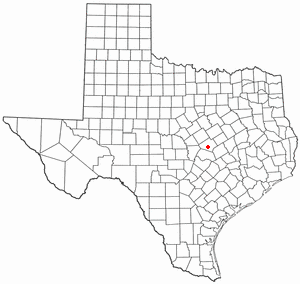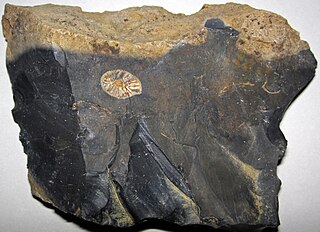
In North American archaeological terminology, a projectile point is an object that was hafted to a weapon that was capable of being thrown or projected, such as a javelin, dart, or arrow. They are thus different from weapons presumed to have been kept in the hand, such as knives, spears, axes, hammers, and maces.

Clovis points are the characteristically fluted projectile points associated with the New World Clovis culture, a prehistoric Paleo-American culture. They are present in dense concentrations across much of North America and they are largely restricted to the north of South America. There are slight differences in points found in the Eastern United States bringing them to sometimes be called "Clovis-like". Clovis points date to the Early Paleoindian period, with all known points dating from roughly 13,400–12,700 years ago. As an example, Clovis remains at the Murry Springs Site date to around 12,900 calendar years ago. Clovis fluted points are named after the city of Clovis, New Mexico, where examples were first found in 1929 by Ridgely Whiteman.

Paleo-Indians, Paleoindians or Paleo-Americans were the first peoples who entered, and subsequently inhabited, the Americas during the final glacial episodes of the late Pleistocene period. The prefix paleo- comes from the Greek adjective palaios (παλαιός) 'old; ancient'. The term Paleo-Indians applies specifically to the lithic period in the Western Hemisphere and is distinct from the term Paleolithic.

In the sequence of cultural stages first proposed for the archaeology of the Americas by Gordon Willey and Philip Phillips in 1958, the Lithic stage was the earliest period of human occupation in the Americas, as post-glacial hunter gatherers spread through the Americas. The stage derived its name from the first appearance of Lithic flaked stone tools. The term Paleo-Indian is an alternative, generally indicating much the same period.

The Adams County Paleo-Indian District is an archaeological site near Sandy Springs in Green Township, Adams County, Ohio, United States.

Silver Mound is a sandstone hill in Wisconsin where American Indians quarried quartzite for stone tools. Tools made from Silver Mound's quartzite have been found as far away as Kentucky. The oldest have been dated to around 11,000 years ago, so they provide clues about the first people in Wisconsin. Silver Mound Archeological District was declared a National Historic Landmark in 2006.

The Thunderbird Archaeological District, near Limeton, Virginia, is an archaeological district described as consisting of "three sites—Thunderbird Site, the Fifty Site, and the Fifty Bog—which provide a stratified cultural sequence spanning Paleo-Indian cultures through the end of Early Archaic times with scattered evidence of later occupation."

The Buttermilk Creek complex is the remains of a paleolithic settlement along the shores of Buttermilk Creek in present-day Salado, Texas, dated to approximately 15,500 years old. If confirmed, the site represents evidence of human settlement in the Americas that pre-dates the Clovis culture.
The Olsen–Chubbuck Bison kill site is a Paleo-Indian site that dates to an estimated 8000–6500 B.C. and provides evidence for bison hunting and using a game drive system, long before the use of the bow and arrow or horses. The site holds a bone bed of nearly 200 bison that were killed, butchered, and consumed by Paleo-Indian hunters. The site is located 16 miles southeast of Kit Carson, Colorado. The site was named after archaeologists, Sigurd Olsen and Gerald Chubbuck, who discovered the bone bed in 1957. In 1958, the excavation of the Olsen-Chubbuck site was then turned over to the University of Colorado Museum of Natural History, a team led by Joe Ben Wheat, an anthropologist employed by the museum.
A Barnes point is a type of projectile point dating from the Paleo-Indian period of American archaeology. It is a large, fluted spear point, lanceolate in shape, with "delicate ears" and a fishtail base. The fluting, or groove in the center of the point, tends to extend nearly the entire length of the point and were mainly used to hunt megafauna.

The Jones-Miller Bison Kill Site, located in northeast Colorado, was a Paleo-Indian site where Bison antiquus were killed using a game drive system and butchered. Hell Gap complex bones and tools artifacts at the site are carbon dated from about ca. 8000-8050 BC.
The Jurgens Site is a Paleo-Indian site located near Greeley in Weld County, Colorado. While the site was used primarily to hunt and butcher bison antiquus, there is evidence that the Paleo-Indians also gathered plants and seeds for food about 7,000 to 7,500 BC.
The Goshen point is a medium-sized, lanceolate-shaped, Paleo-Indian projectile point with a straight or concave base. It exhibits characteristic fine flaking.

The Dent site is a Clovis culture site located in Weld County, Colorado, near Milliken, Colorado. It provided evidence that humans and mammoths co-existed in the Americas.
The Vail Pass Camp is a multi-component prehistoric site, situated at the summit of Vail Pass, just below the timberline in Colorado. The camp was occupied for over 7000 years, inhabited by various North American aboriginal groups, and is the first open lithic-scatter site. Thirty-three radiocarbon dates were obtained, ranging from 7320 B.P. to 190 B.P. with most dating to the last 3,000 years. The Vail Pass Camp was most likely discovered in 1887 by T.D.A Cockerell.
Domebo Canyon, Oklahoma is a Paleo-Indian archaeological site: the site of a mammoth kill in the prairie of southwestern Oklahoma. The Domebo archaeological site features deposits of both incomplete and partially articulated mammoth skeletal remains. Also found at the site were two complete and one fragmentary projectile point, along with three un-worked tool flakes made by prehistoric hunters who lived during the Pleistocene Epoch.
The Paw Paw Cove Site is an archaeological site on the coast of Talbot County, Maryland. The site, first identified in 1979, is a complex of three locations on 500 metres (1,600 ft) of shoreline on Chesapeake Bay, at which stone artifacts with an estimated date of 11,500 to 10,500 BCE have been found. Among the finds are fluted projectile points and flakes created during the manufacture of such points.
The Quad site is a series of Paleoindian sites and localities in Limestone County near Decatur, Alabama. It was first reported by Frank Soday in 1954, and later findings were also documented by James Cambron, David Hulse and Joe Wright and Cambron and Hulse. The Quad Locale can seldom be viewed at current lake levels, even during normal winter pool, due to extensive erosion, but is considered one of the most important and well known Paleoindian sites in the Southeastern United States.
Sheriden Cave is a Paleo-Indian archaeological site from the late Ice age in Wyandot County, Ohio. Glacial deposits sealed off the cave more than 10,000 years ago. Sheriden Cave is a karst sinkhole on a dolomite ridge that crosses Hancock and Wyandot Counties. It is associated with the Indian Trail Caverns that opened in 1927. Sheriden Cave was discovered in 1989. The cave is unique because in addition to stone tools, there were also bone tools, remains of extinct animals, and organic matter found in the cave. Radiocarbon dating of artifacts indicate that they were used 11,000 and 12,000 years ago.

The Welling site is an archaeological site of the Paleo-Indian period, meaning the time of the earliest humans. Located in Coshocton County, Ohio, it was a site for quarrying stone in the Upper Mercer chert source area. Based upon the microwear analysis of stone tools, it is believed to be a base camp where people learned and shared Clovis tool-making techniques, ate, exchanged information, and perhaps found mates from others groups.












